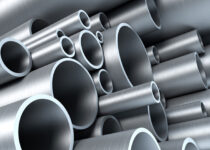Advantages of Steel Scaffoldings in Construction Industry

Advantages of Steel Scaffoldings in the Construction Industry: The construction industry is one of the most vital sectors in the global economy. It plays a significant role in shaping cities and communities, providing infrastructure, and contributing to economic growth. Within this industry, scaffoldings are an indispensable element, providing support and safety for workers during construction, renovation, and maintenance projects.
Among the various types of scaffoldings available, steel scaffoldings like pipes and tubes, cuplock system, scaffold steel board plank, etc. stand out as a preferred choice due to their numerous advantages, playing a crucial role in ensuring safety, efficiency, and structural integrity in construction projects of UAE, Saudi Arabia and other Middle East countries.
Benefits of Using Steel Scaffoldings: In Middle East Construction Industry

In the dynamic Middle East and other MENA construction industry for Petrochemical Oil & Gas, towering skyscrapers, and bridges, the use of steel scaffoldings offers multifaceted benefits. Their robustness and durability withstand the region’s diverse climate conditions, ensuring safety for workers during skyscraper construction and infrastructure projects. Steel scaffoldings provide the necessary support for intricate designs, contributing to the rapid growth of iconic structures like the Burj Khalifa.
The adaptability, quick assembly, and compliance with stringent safety standards make steel scaffoldings – pipes and tubes, cuplock system, scaffold steel board plank and others indispensable in the development of advanced architectural feats across the Middle East. Moreover, their cost-effectiveness and eco-friendly nature align with the industry’s focus on sustainable practices, showcasing steel scaffoldings as an essential and advantageous component in the region’s construction landscape. Let’s discuss each advantage of steel scaffolding in detail below.
Advantages of Steel Scaffoldings in Construction Industry

Steel scaffoldings stand as a cornerstone in the construction industry, offering unparalleled advantages. With their robustness, safety features, and adaptability, they ensure stability, efficiency, and safety on construction sites, revolutionizing the way structures are built.
Strength and Durability of Steel scaffoldings
Steel scaffoldings are renowned for their exceptional strength and durability. Unlike other materials, such as wood or aluminum, steel offers superior load-bearing capacity, enabling it to support heavier weights. This durability makes it an ideal choice for various construction projects, providing a stable platform for workers to carry out tasks effectively and safely.
Safety of Construction Workers at Working Place
The safety of construction workers is of paramount importance. Steel scaffoldings offer a high level of safety due to their robustness and stability. They can withstand harsh weather conditions and heavy loads, minimizing the risk of collapse or accidents. Steel scaffoldings are engineered to comply with strict safety standards, ensuring the protection of workers while working at heights.
Versatility of Steel Scaffoldings to Suit Projects
Steel scaffoldings are versatile and can be customized to suit various project requirements in the Petroleum and Oil & Gas, high ridges buildings, bridges construction in the Middle East, UAE, Saudi Arabia. They come in different shapes and sizes, allowing for easy adjustment and modification as per the needs of the construction site. This adaptability makes them suitable for a wide range of construction projects, from simple residential buildings to complex industrial structures.
Longevity of Steel Scaffoldings
Steel scaffoldings have a longer lifespan compared to other materials. They are resistant to rust, corrosion, and degradation, ensuring they maintain their integrity over an extended period. This longevity reduces the need for frequent replacements or repairs, making them a cost-effective choice for construction companies.
Ease of Assembly and Dismantling of Steel Scaffoldings
One of the significant advantages of steel scaffoldings is their ease of assembly and dismantling. They are designed for quick installation and removal, saving time and labor costs. The efficiency of erecting and dismantling steel scaffoldings allows for smoother progress of construction projects, enhancing overall productivity.
Environmental Benefits of Steel Scaffoldings
Steel scaffoldings are eco-friendly as they are recyclable and contribute to sustainability. Steel is a highly recyclable material, reducing the environmental impact of construction projects. Reusing steel scaffoldings not only minimizes waste but also conserves natural resources, aligning with green building practices.
Cost-Effectiveness of Using Steel Scaffoldings
Despite an initial higher cost compared to some other materials, steel scaffoldings prove to be cost-effective in the long run. Their durability, low maintenance requirements, and reusability make them a wise investment for construction companies. The reduced need for replacements and repairs leads to long-term savings.
Regulatory Compliance for Steel Scaffoldings
Steel scaffolding products – Pipes and Tubes, Cuplock Systems, Tube and Fittings, Caster Wheel, Scaffold Steel Board Plank, Ladder Beams and Lattice Beams, etc, manufactured and supplied by Spar Steel Industries often align with industry standards and regulations like American – ASTM and API standards, British Standard (BS), European Norm (EN) and other Middle East local standards ensuring that construction projects meet safety and quality requirements set by authorities. Using steel scaffoldings helps construction companies comply with these regulations, reducing legal liabilities and ensuring a safer work environment.
Case Studies and Real-Life Examples of Using Steel Scaffoldings

Several construction projects worldwide have successfully utilized steel scaffoldings, showcasing their advantages. For example, the construction of skyscrapers, bridges, and large commercial buildings commonly employs steel scaffoldings due to their robustness and capacity to handle heavy loads.
1. Burj Khalifa in Dubai Used Steel Scaffolding
The Burj Khalifa in Dubai, the tallest building in the world, extensively used steel scaffoldings during its construction. The strength and adaptability of steel scaffoldings were vital in ensuring the safety of workers while facilitating the building’s complex design.
2. Golden Gate Bridge in San Francisco
Similarly, the Golden Gate Bridge in San Francisco utilized steel scaffoldings for maintenance and painting work. The ability of steel scaffoldings to withstand extreme weather conditions and provide a stable platform for workers contributed to the success of the project.
Conclusion
Spar Steel scaffoldings play a pivotal role in the construction industry of Dubai, UAE, Saudi Arabia, Qatar, Oman, and other MENA’s countries, offering numerous advantages that contribute to the safety, efficiency, and success of construction projects. Their strength, durability, safety features, and environmental benefits make them a preferred choice for construction companies worldwide.
As the construction industry continues to evolve, the utilization of steel scaffoldings will remain integral in ensuring the structural integrity and safety of construction sites. By leveraging the advantages of steel scaffoldings, construction projects can proceed smoothly, ensuring the well-being of workers and the successful completion of structures that shape our world.
FAQs on Advantages of Steel Scaffoldings in Construction Industry
Q. What are the advantages of steel scaffolding?
Ans. Steel scaffolding offers unparalleled advantages in construction work like superior strength, durability, and safety. Its robustness ensures stability for workers at heights, withstanding heavy loads and diverse weather conditions. Versatility, ease of assembly, longevity, and environmental friendliness make steel scaffolding a cost-effective and reliable choice for construction projects in the Middle East and MENA.
Q. What is the use of steel scaffolding?
Ans. Steel scaffolding is used in construction to provide a stable platform for workers at elevated heights. It supports workers, tools, and materials, ensuring safety during building, maintenance, or renovation. Its robust structure and adaptability make it essential for diverse construction projects, ensuring a secure working environment.
Q. What is the role of steel scaffolding in the construction industry?
Ans. Steel scaffolding plays a pivotal role in the construction industry by offering a stable and secure platform for workers at elevated heights. It ensures safety, supports heavy loads, and enables efficient access, contributing to the smooth progress of construction, maintenance, and renovation projects, enhancing overall safety and productivity.
Q. Why choose steel scaffoldings over other materials for construction purposes?
Ans. Steel scaffoldings offer unparalleled strength and durability, ensuring the safety of workers at elevated heights. Unlike other materials – timber and bamboo, steel provides exceptional load-bearing capacity, withstanding heavier weights and adverse weather conditions. Its robustness and longevity make it a preferred choice for construction, ensuring stability and safety.
Q. How do steel scaffoldings contribute to cost-effectiveness in construction projects?
Ans. Despite a higher cost in the beginning, steel scaffoldings prove cost-effective in the long run. Their durability and longevity reduce the need for frequent replacements or repairs, saving on maintenance expenses. Moreover, their ease of assembly and dismantling saves time and labor costs, enhancing overall project efficiency.
Q. Are steel scaffoldings environmentally friendly?
Ans. Yes, steel scaffoldings align with eco-friendly practices in the construction industry. They are recyclable, reducing environmental impact and contributing to sustainability. The recyclability of steel minimizes waste and conserves natural resources, making them a greener choice for construction projects, aligning with global sustainability efforts.



